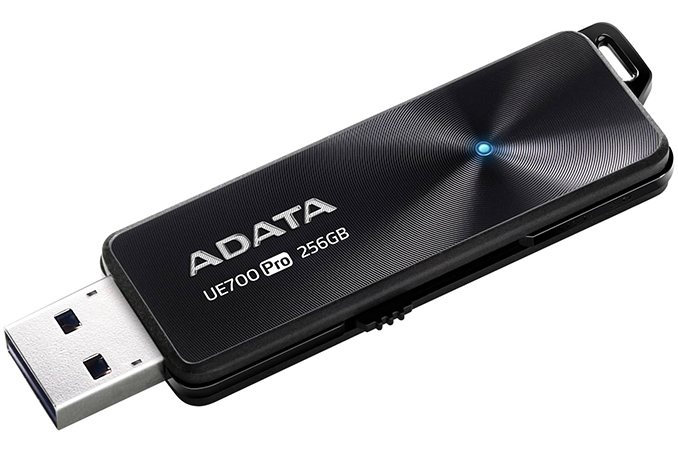ADATA Unveils Ultra-Compact UE700 Pro External Flash Drives: Up to 360 MB/s
by Anton Shilov on December 12, 2018 11:00 AM EST- Posted in
- Storage
- USB 3.0
- ADATA
- USB Type-A

ADATA has released a new lineup of USB flash drives that combines compact dimensions, high capacity, and high performance (in case of high-end models). The UE700 Pro drives come in a metallic chassis and are aimed at those who always carry a flash drive and need a sturdy enclosure. Meanwhile, the product is USB 3.0 Type-A only and will need an adapter to work with modern laptops.
The ADATA UE700 Pro flash drives come in 32 GB, 64 GB, 128 GB, and 256 GB configurations. The range-topping 256 GB model features read and write speeds of respectively up to 360 MB/s and 180 MB/s, allowing it to be amongst the fastest USB 3.0 flash drives ever released.
ADATA does not disclose which controller or flash memory it uses for its UE700 Pro, but considering how fast the drive is, it is logical to assume that the company installs 3D NAND with a relatively high I/O speed.
The UE700 Pro drives come in a brushed aluminum enclosure that is 7 mm thick, 63 mm long, and weighs 11 grams. This is hardly the most compact chassis around, but the positive of relatively larger flash drive is that it is harder to lose. The USB Type-A connector of the drive can be slided in and out in a bid to protect it while carrying the device around.
ADATA already lists the new UE700 Pro flash drives on its website, so expect them to hit various markets in the coming weeks. The company has not announced pricing, but expect the lower-capacity models to fall in the same cost range as competitor offerings featuring similar capacity and performance, whereas the 256 GB SKU will carry a premium price tag due to its speeds and increased capacity.
Related Reading:
- Exploring Performance Consistency in USB 3.0 Flash Drives
- Mushkin at CES 2018: CarbonEXT 1 TB USB 3.0 SSD, Swap USB Type-A & Type-C Drive
- Plextor Launches EX1 USB-C External SSD: Up to 550 MBps, 512 GB and LDPC
Source: ADATA












9 Comments
View All Comments
nicolaim - Wednesday, December 12, 2018 - link
"can be slided in and out"That should be "slid"
DanNeely - Wednesday, December 12, 2018 - link
And of course no mention of the speeds of the smaller capacity models that will be sold in multiple orders of magnitude larger quantities.Death666Angel - Wednesday, December 12, 2018 - link
If you aren't a penny pincher and need the best volume per capacity, you should consider going with an M.2 SATA SSD and a corresponding all in on case that makes it look like a modestly oversized USB stick. I'm currently waiting on the case/adapter from China for 7€ and am going to buy either a 250GB range SSD or a 1TB SSD and replace my 500GB notebook one. Price/GB isn't outlandishly different at those capacities and it gets better the larger they are.PeachNCream - Wednesday, December 12, 2018 - link
I've done that with a 120GB mSATA before and it worked rather well as a fast thumb drive. The connector was obviously on a cable so the increased size didn't cause a problem by blocking nearby ports. I did go through a couple of cables, but I blame that stupid USB 3.0 connector. Those were always a bit iffy.CrazyElf - Wednesday, December 12, 2018 - link
The issue is the case. There needs to be a good M.2 to USB case out there that can withstand abuse and use the USB 3.1 bus to its speed limits.SquarePeg - Wednesday, December 12, 2018 - link
I like this one as it only accepts M.2 2242 SATA but they do sell a larger 2280 model. It's very small and light.https://www.amazon.com/SilverStone-Technology-Encl...
oRAirwolf - Friday, December 14, 2018 - link
Not sure that this is even newsworthy. The lack of information about the controller and NAND it is using makes this completely uninteresting. There are quite a few USB drives that offer this type of performance. Now a USB 3.1 Gen 2 Corsair Voyager GTX would be interesting, though. That or an NVMe compatible USB 3.1 Gen 2 Silverstone USB enclosure with a slide-out connector.digiguy - Friday, December 14, 2018 - link
Yeah, Corsair GTX is still the king of fast true pen drives... a gen 2 (10Gbs) or even TB3 (40Gbs) version of it (with NVMe inside) would the next step forwardImpulses - Tuesday, December 18, 2018 - link
I thought I was in a time warp... I bought a UE700 (not Pro) with an identical chassis back in 2013 (same little pleather strap and all), and looking back at the specs it wasn't even *that* much slower given the 5 year gap (200MB/s read and 95MB/s write)...Not sure I see the point of these mid-sized drives these days, I tend to gravitate towards the tiniest keychain type drives or something the size of an M.2 that can hit 500/500-ish like SanDisk's Extreme Portable USB-C.